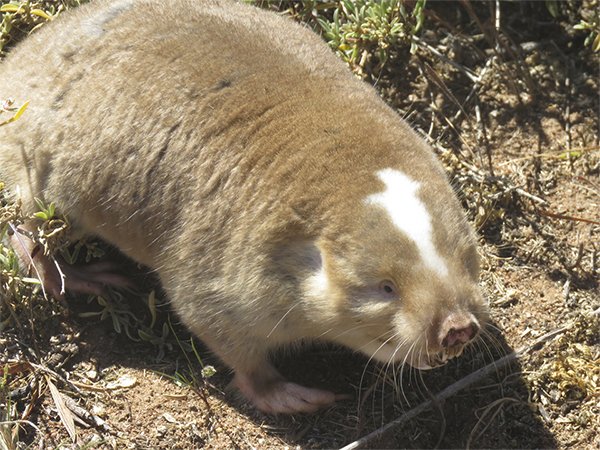My, What Small Eyes and Large Teeth You Have!
Dwergenpaartje, CC BY-SA 4.0 https://creativecommons.org/licenses/by-sa/4.0, via Wikimedia Commons
Bathyergidae
by Inspector Barry Mins on March 29, 2022Hey kids, welcome back to our series on the mysteries of created kinds!
This week we are back to Africa, specifically sub-Saharan Africa, looking for some small creatures, well-known for their ability to burrow.

This kind lives almost exclusively underground, shunning light to live in burrows of its own construction. They lack external ears, have very small eyes, and are equipped with large teeth they use for burrowing.1 They are active burrowers and explorers, readily adapting to the unpredictable nature of life underground.2 The burrows they build have very stable internal climates, with little daily variation in temperature or humidity.3 They build these burrows with their powerful teeth and jaws. In fact, this kind has one of the most powerful bites for its size among all mammals.4 Many members of this kind are almost immune to pain and can resist the effects of multiple painful substances.5,6
Most of these species are solitary, only breeding during an abbreviated period that coincides with maximum rainfall for their habitat.7 In other species, mating occurs during the cold portion of the year and young are born during the hot time of year.8 In some species that are colonial, the breeding queen will live longer than the females involved with caring for the young and will provide for the colony.9
Has anyone figured it out yet? This week might be hard, not because I omitted information, but because this kind is simply rarely discussed on nature documentaries or articles. This week’s kind is the Bathyergidae, or the Blesmols. These shy rodents can burrow through almost anything and are relatively common in Africa, but are not as famous as the naked mole rats which we will cover another time.

Dwergenpaartje, CC BY-SA 4.0 https://creativecommons.org/licenses/by-sa/4.0, via Wikimedia Commons
Try out this fun crossword puzzle! Next week we move to South America looking for a mammal with a lot of extinct relatives.
Clue
Your clue for the next week is:
This spotted mammal lives in small groups in the jungles of the Amazon, preferring life in the trees to life on the ground.
Ask a Question
Have you ever had a question about created kinds but didn’t know who to ask? Have you ever wanted to learn more about your favorite kind? Well, now you can! You can ask me, Inspector Barry Mins, a question! Have your parents help you fill out this form, and you might get your question answered in my column! If you have any questions about created kinds, feel free to send them my way!
Footnotes
- J.T. Du Toit, J.U.M. Jarvis, and G.N. Louw. Nutrition and burrowing energetics of the Cape mole-rat Georychus capensis. Oecologia, 66 (1985), pg 81-87.
- Maria K. Oosthuizen, Anne-Gita Scheibler, Nigel C. Bennett, and Irmgard Amrein. Effects of laboratory housing on exploratory behaviour, novelty discrimination and spatial reference memory in a subterranean, solitary rodent, the Cape Mole-Rat (Georychus capensis). PLoS One, 2013.
- Radim Sumbera, W.N. Chitaukali, M. Elichova, J. Kubova, and H. Burda. Microclimate stability in burrows of an Afrotropical solitary bathyergid rodent, the silvery mole-rat (Heliophobius argenteocinereus). Journal of the Zoological Society of London. 263, (2004), pg 409-416.
- P.A.A.G. Van Daele, Anthony Herrel, And Dominique Adriaens. Biting performance in teeth-digging African mole rats (Fukomys, Bathergidae, Rodentia). Physiological and Biochemical Zoology, 82, no1 (2009), pg 40-50.
- Ole Eigenbrod et al. Rapid molecular evolution of pain insensitivity in multiple African rodents. Science, 364 (2019), 852-859.
- For more information, ask your parents to show you my colleague Troy Lacey’s article on the main website entitled "Evolved to feel no pain?”
- N.C. Bennett, L. Hart, M.J. O’Rian, and J.U.M. Jarvis. Is the cape dune mole rat, Bathygerus suillus (Rodentia: Bathygergidae) a seasonal or aseasonal breeder? Journal of Mammalogy, 87, no. 6 (2006), pg 1078-1085.
- Radim Sumbera, Hynek Burda, and Wilbert N. Chitaukali. Reproductive biology of a solitary subterranean bathyergid rodent, the silvery mole-rat (Heliophobius argenteocinereus). Journal of Mammalogy, 84, no. 1 (2003), pg 278-287.
- Christina M. Schmidt, Jennifer U.M. Jarvis, and Nigel C. Bennett. The long-lived queen: reproduction and longevity in female eusocial Damaraland mole-rats (Fukomys damarensis). African Zoology, 48, no. 1 (2013), 193-196.
- © 2025 Answers in Genesis
- Privacy Policy
- Contact
- About
